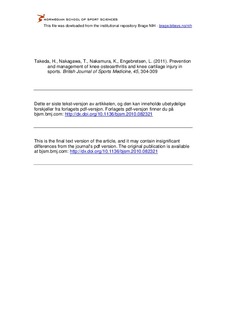| dc.contributor.author | Takeda, Hideki | |
| dc.contributor.author | Nakagawa, Takumi | |
| dc.contributor.author | Nakamura, Kozo | |
| dc.contributor.author | Engebretsen, Lars | |
| dc.date.accessioned | 2011-08-19T07:08:01Z | |
| dc.date.available | 2011-08-19T07:08:01Z | |
| dc.date.issued | 2011-02-25 | |
| dc.identifier | Seksjon for idrettsmedisinske fag / Department of Sports Medicine | |
| dc.identifier.citation | British Journal of Sports Medicine. 2011, 45(4), 304-309 | en_US |
| dc.identifier.issn | 0306-3674 | |
| dc.identifier.uri | http://hdl.handle.net/11250/170871 | |
| dc.description | I Brage finner du siste tekst-versjon av artikkelen, og den kan inneholde ubetydelige forskjeller fra forlagets pdf-versjon. Forlagets pdf-versjon finner du på bjsm.bmj.com: http://dx.doi.org/10.1136/bjsm.2010.082321 / In Brage you'll find the final text version of the article, and it may contain insignificant differences from the journal's pdf version. The original publication is available at bjsm.bmj.com: http://dx.doi.org/10.1136/bjsm.2010.082321 | en_US |
| dc.description.abstract | Articular cartilage defects in the knee of young or active individuals remain a problem in orthopaedic practice. These defects have limited ability to heal and may progress to osteoarthritis. The prevalence of knee osteoarthritis among athletes is higher than in the non-athletic population. The clinical symptoms of osteoarthritis are joint pain, limitation of range of motion and joint stiffness. The diagnosis of osteoarthritis is confirmed by the symptoms and the radiological findings (narrowing joint space, osteophyte formation and subchondral sclerosis). There is no strong correlation between symptoms and radiographic findings. The aetiology of knee osteoarthritis is multifactorial. Excessive musculoskeletal loading (at work or in sports), high body mass index, previous knee injury, female gender and muscle weakness are well-known risk factors. The high-level athlete with a major knee injury has a high incidence of knee osteoarthritis. Cartilage injuries are frequently observed in young and middle-aged active athletes. Often this injury precedes osteoarthritis. Reducing risk factors can decrease the prevalence of knee osteoarthritis. The prevention of knee injury, especially anterior cruciate ligament and meniscus injury in sports, is important to avoid progression of knee osteoarthritis. | en_US |
| dc.language.iso | eng | en_US |
| dc.publisher | BMJ | en_US |
| dc.subject | autologous chondrocyte implantation | en_US |
| dc.subject | anterior cruciate ligament | en_US |
| dc.subject | arthroscopic partial meniscectomy | en_US |
| dc.subject | tibial plateau fractures | en_US |
| dc.subject | 3-year follow-up | en_US |
| dc.subject | long-term | en_US |
| dc.subject | articular cartilage | en_US |
| dc.subject | physical activity | en_US |
| dc.subject | chondral defects | en_US |
| dc.subject | soccer players | en_US |
| dc.title | Prevention and management of knee osteoarthritis and knee cartilage injury in sports | en_US |
| dc.type | Journal article | en_US |
| dc.type | Peer reviewed | en_US |
| dc.subject.nsi | VDP::Social science: 200::Social science in sports: 330::Other subjects within physical education: 339 | en_US |
| dc.source.pagenumber | 304-309 | en_US |
